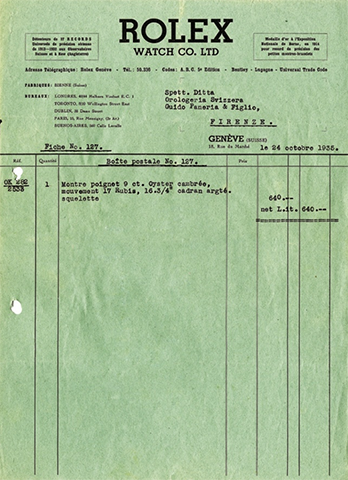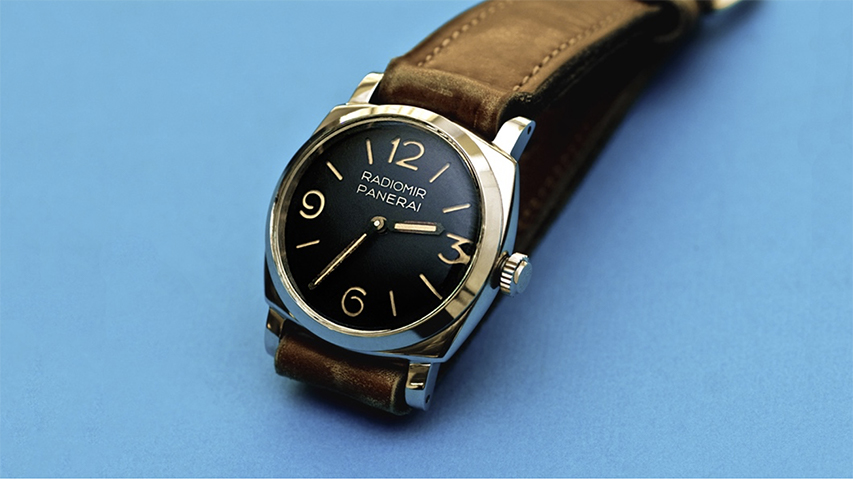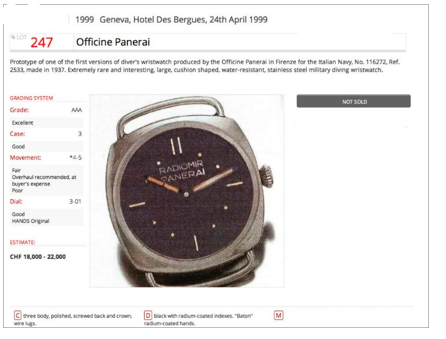The mysterious Panerai ref. 2533 with a sandwich quadrant, so called because it was composed of two overlapping parts, is considered one of the first, if not the real first Radiomir watch ever realized. The sandwich inferior part was made by a "small box" to contain the Radio mix, while the upper part was a disk with numbers and perforated indexes to read the time. For this unreal watch, that remains always in Francesco Ferretti collection, probably the biggest Panerai expert, an enigma exists since a long time, as long as in 2010 Ferretti offered to Ms. Maria Teresa Panerai a large sum of money to let him take all what he wanted in Mr. Giuseppe Panerai’s office. Maria accepted this deal, and Ferretti had access to a kingdom that had remained intact since Giuseppe's death in February 1972. In fact, the Swiss holding Richemont, that in 1997 acquired the Panerai workshop, in reality acquired only its brand, while for decades its know-how remained Maria ownership. Since the beginning, Ferretti found a variety of ingenious calculation devices for naval applications, instruments, lamps, watches, technical drawings as well as several documents. As he rummaged through these testimonies, his attention dwelt on three Rolex invoices from the 1930s relating to the supply of some items ref. 2533. With these findings, Ferretti had the official and certain confirmation – he was desperately waiting for it since years, about his theories regarding this enigmatic reference, always ignored by Panerai lovers. To understand the beginning of the so-called Panerai watches it is fundamental to watch closer these documents; however, first it is important to know why these watches were created. In October 1935, Elio Toschi and Teseo Tesei, two Italian engineers together with thirty staff members of the workshop for the development of submarine units of the Royal Italian Navy just completed the first prototype of a new gun, the underwater slow running torpedo named SLC.
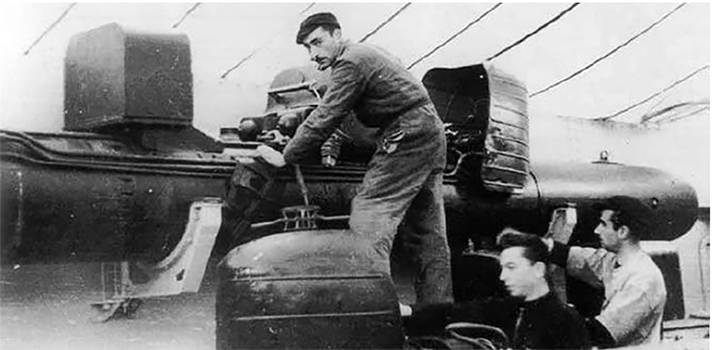 |
| fig. 1 - Elio Toschi and Teseo Tesei with the underwater slow running torpedo |
It was a torpedo with a crew on horseback that could navigate both above and underwater, to be able to sneak underwater in enemy ports and apply a 225 kg. TNT warhead to the hull of the ships to blow them up.
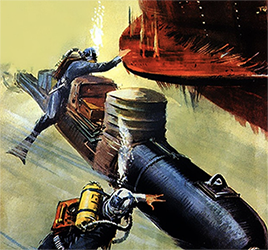 |
| fig. 2 - Operatori di un SLC che posizionano una testata allo scafo di una nave |
Few days after the first tests of the SLC Giuseppe Panerai, director of the G. Panerai & Son company of Florence, already a competent and reliable supplier of special equipment for the Navy since few years, received a phone call from the Royal Navy asking for a meeting.
The appointed officer arrived to Panerai villa in Florence; Giuseppe Panerai, who loved Navy because he admired its lifestyle and attitude, carefully listened what the uniform men had to say. When it was asked to design a water-resistant compass and a watch for the torpedo operators, he immediately understood that Navy developed something completely revolutionary. His first difficulty was that, at that time, the fascist government introduced in Italy autarky (independence from foreign resources); Panerai was not a watch producer therefore, he had to find a solution to this issue.Intuition to Giuseppe Panerai arrives when he remembers to have seen, in the last Rolex catalogue, an unusual Oyster watch with Radium treatment, the first watch resistant to water and dust that, probably, could have satisfied the high Navy needs.
 |
| fig. 3 - Ristampa di un catalogo Rolex del 1935 |
The watch arrived in November of 1935; it was huge; its oversize case remembered a pillow shape; it was gold, with a diameter of 47 mm. This was an Oyster small pocket watch transformed in a spectacular wristwatch, where all indications, included the small second needle at 9, had been skeletonized to receive large amounts of radium self-luminous paint. Numbers in the watch face, besides being very big, were painted with radio.
 |
|
fig. 4 - Evolution of the Rolex Oyster ref. 2535 |
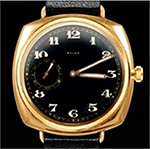 |
| fig. 5 - Copia del Rolex ref. 2533 |
To testimony how an exclusive Oyster small pocket watch transformed in the most mysterious Rolex wristwatch never realized it is the following Rolex invoice, found in the office of Giuseppe Panerai in Florence. We can read that one Rolex watch ref. 2533 with a 9 Kt golden case and 16 ¾ Ligne movement with 17 rubies (probably a Montilier 663) was sent to Florence on October 24, 1935..
|
|
| fig. 6 - Rolex invoice of one Rolex watch ref. 2533 dated October 24, 1935 |
|
|
| fig. 7 - The caliber 663 number consists of the bridge arrangement, in this case n. 6 and size 63 (16 3/4 Ligne) |
|
|
| fig. 8 |
Ironically, the first watch with ref. 2533 for underwater use seemed more a fashion watch then a military instrument however, it was largely tested by the Italian Navy and, at the end, approved. At this point, Panerai made an order of 19 pieces that Rolex sent to Florence on June 13, 1936 to be finally tested, and delivered to the Navy.
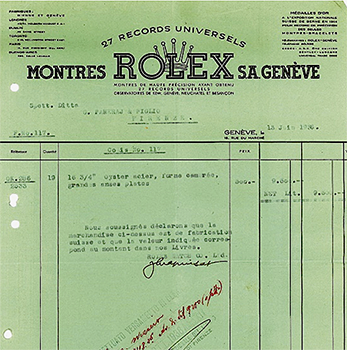 |
| fig.9 - invoicen. 117/1936 - Translation: reference 2533, Quantity: 19, 16 Oyster steel of 3/4", curved shape, large flat bends. The undersigned declare that the goods mentioned above are of Swiss production, and that the mentioned value corresponds to the amount in our price lists |
|
|
| fig. 10- Panerai Radiomir watch of 1937, directly originated from the golden Rolex ref. 2533 of 1935 |
To be clear on the fact if Panerai manufactured or not these watches dedicated to the Navy, we can reference to one invoice of a second lot of 15 watched with reference 2533. In this invoice, firstly watches are described as special Oyster watches for divers and secondly, this invoice specifies clearly that this lot is equipped with watch faces supplied by Panerai. It is extremely interesting to see that this is explicitly mentioned in this invoice, and not in the previous one, because we can presume that Oyster watches Oyster supplied with the first lot of 19 pieces were equipped with the Rolex face while, in the second supply watches mounted a face that Panerai or a third party produced, to be then sent to Rolex for their final assembling. In fact, the first Panerai faces bear a Zelime Jacot stamp on the face base; Zelime Jacot was a famous Swiss face producer, currently existing with the name of Cadrans Flückiger SA.
 |
| fig. 12 - fattura 202/1939 - Translation: Reference 2533, Quantity: 15, Oyster in special steel for divers (faces supplied by Panerai, without leather, nor boxes. We certify that the above-mentioned invoiced goods are of Swiss production, and that the mentioned value corresponds to the amount in our price lists. |
Of this phantom Rolex Oyster ref. 2533 watch only a bad picture exists, which was published in a Rolex catalogue in that far 1935 and, today, we do not know about any example. Also, we presume that only two pieces were produced, one purchased by Panerai, as the invoice profs and, another one of which traces are lost.
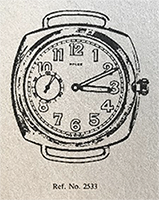 |
| fig. 13 - Picture of Panerai ref. 2533 watch published in the Rolex catalogue of 1935 |
|
|
| fig. 14 |
The famous ref. 2533 with Baton quadrant and case number 116272 made its first public appearance in April. Lot 247 was described as a prototype of one of the real first version of diving watches made by Panerai workshop for the Italian Military Navy.
 |
| fig. 15 |
In this picture, you see probably the first Panerai watch ever produced, with the Baton quadrant, and a second watch with a classis sandwich quadrant of Radiomir, with a different mechanism. This watch was given to Commander Mario Giorgini, mission chief of the submarine Gondar who, after the self-sinking of the submarine so as not to reveal the SLCs stowed in their containers, was taken prisoner and sent to Bombay in captivity. Currently, these are the only 2 examples of ref. 2533, which are known.
______________
